note: below is a guest post (a first!) penned by Karla Olson, who has been carrying much of the New Westminster Environmental Partners load on her back this year. She has also spent the last three years applying her considerable project management skills towards making the local portion of the Great Canadian Shoreline Cleanup as successful as possible. The 2013 event is coming up soon- and I hope you will take part!
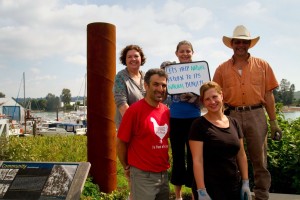 |
| Site prep team on Queensborough’s South Dyke Road last week: (LtoR) Karla Olson (author), Patrick Johnstone, Jaycee Clarkson, Lisa Egan and Harry Buchholz. |
Help Nature Return to Its Natural Beauty
Next Sunday, starting from 9:30AM, is the South Dyke Road Riverfront Cleanup in Queensborough. A family-friendly event, it is open to everyone who welcomes taking care of our shoreline. Volunteer to take part in a variety of activities, from active to easy.
At last year’s Shoreline Cleanup, 79 participants removed about 165 kg of litter and invasive species. People came from Surrey, Delta, and Vancouver, and included Councillor Jonathan Cote, as well as Fin Donnelly, MP. Some of the littered items collected included an oven, a refrigerator door, a microwave, 6 tires, a barrel that was estimated to be forty years old, and bags and bags of waste produced from daily human activities.
Along with all of the garbage and invasives removed, what is equally impressive is how experienced people are getting at doing these cleanups.
Last year, one couple from Surrey removed 4 of the 6 tires, the barrel, and huge blocks of Styrofoam from the river. This year, when I took part in the Queensweep Cleanup with NWEP member Jaycee Clarkson, I was so impressed by the ingenuity of Lisa Egan and her family. They used garbage pickers to get at the litter stuck in the ditches, and the kids’ wagon was a perfect addition to help carry it all.
Besides litter, another concern for this shoreline area is the dumping of yard waste that is occurring. Most likely people think because it is organic that it doesn’t do any harm. But what they don’t realize is that they are introducing non-native species into the habitat and adding nutrients that create an imbalance to this ecosystem.
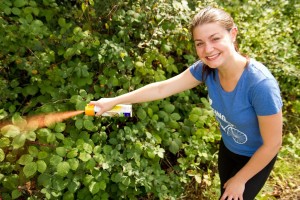 |
| Jaycee Clarkson, NWEP member, spraying blackberry in prep for the Invasive Plant Pull Shoreline Cleanup 2013 |
What Makes a Plant Invasive?
Plants are considered invasive for two reasons. One reason is because people or animals have brought them from their original natural habitat to a different one; they are non-native plants. Which non-native plants become invasive depends on their adaptability—how quickly they grow and multiply in the new habitat.
When non-native plants grow quickly, they take over and force native plants from their home. They rob them of their space, sunlight, water, and nutrients. Over time, these invasive plants change and damage the conditions of the natural habitat. For these reasons, invasive plants are carefully removed to not spread their seeds or other plant parts that can regrow from special habitats like—our Fraser River shoreline.
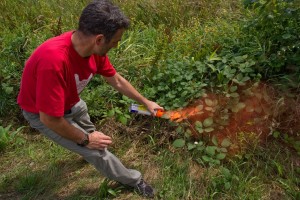 |
| Patrick Johnstone tagging invasive plants for the 2013 Shoreline Cleanup |
For those of us who love the taste of blackberries, it can be hard to learn that the Himalayan blackberry is considered an invasive plant (Invasive Species Council of British Columbia). But one of the best ways to stop it from spreading is to eat the berries before their seeds grow new ones! Now that berry season is over, it’s important to minimize the hazard of the plant’s long shoots, which can be hazardous to humans and animals alike.
Invasive Plant Tagging
Two site visits were done in preparation for the cleanup to target those invasives that are best to remove—morning glory, Lamium, bamboo, English ivy and Himalayan Blackberry—by tagging them with orange or white paint. The first visit with Claude Ledoux, Parks Horticulture Manager, helped to verify the success of our volunteer efforts.
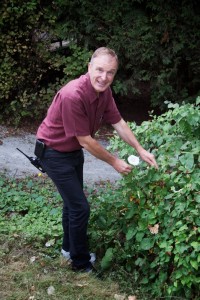 |
| Claude Ledoux, City’s Parks and Horticulture Manager, identifying morning glory. |
Some invasive plants can take years to completely remove once they have been introduced. But even so, the minimal re- growth of these plants in the areas that were pulled last year was quite apparent. Our efforts are really having a positive impact.
Data Collection
In addition to the invasive pull and picking up garbage, an important activity is collecting data on the numbers and types of garbage found. By keeping track of what’s collected by members of your team, participants help shine a light on the types of litter people throw out and which types make up the most garbage. This information leads to understanding the behaviours that trigger littering and to finding ways to stop it from happening. If you would like to help out with this activity, please bring a clipboard, if you have one, and a pen.
To show how much litter was collected, a graph will be displayed at RiverFest on Saturday, Sept 28 to show just how much litter was collected.
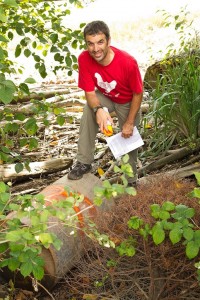 |
| Patrick Johnstone, NWEP member, standing on an oil drum recently washed up onto the Shoreline |
And if participants find any “unexpected” litter that can be kept safely, it will be on display at RiverFest too. Hint: Expect to see a lot of cigarette butts that will be bagged to go to TerraCycle, a company that specializes in recycling previously non-recyclable items, such as pens, inkjet cartridges, and Tassimo coffee, tea, espresso, milk and hot chocolate T Discs.
Show Your Love for the Fraser River: Join the South Dyke Road Riverfront Cleanup
For us in New Westminster, this Shoreline Cleanup launches the start of RiverFest, an art and environmental festival inspired by the Fraser River that celebrates BC Rivers Day at the Fraser River Discovery Centre. It is also part of the Great Canadian Shoreline Cleanup™, an annual event that helps keep our oceans, rivers, and lakes healthy. People from all across Canada join in to remove the human-made litter and garbage that was either dumped or accidently deposited into our water systems.
This year on Sunday, Sept 22, at 9:30am, meet at the Spagnol Street Walkout on South Dyke Road to join in. To register and get more info on the Shoreline Cleanup, click on the link—Registration isn’t necessary, but does help with planning.
Attention: YOUTH, participants under 19, if you are taking part without your parents or guardians you need to bring 2 signed waivers with you and you can find them on the New Westminster Environmental Partners’ website, nwep.ca and go to the Shoreline Cleanup menu tab.
The South Dyke Road Riverfront Cleanup is organized by New Westminster Environmental Partners (NWEP) in partnership with the City of New Westminster and the Fraser River Discover Centre.
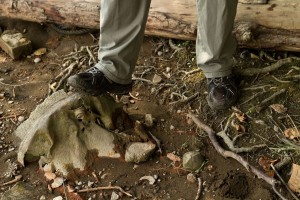 |
| Patrick Johnstone Standing on Oil Drum Submerged in our NW Shoreline |